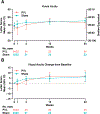Pneumatic Vitreolysis with Perfluoropropane for Vitreomacular Traction with and without Macular Hole: DRCR Retina Network Protocols AG and AH
- PMID: 33989683
- PMCID: PMC8545749
- DOI: 10.1016/j.ophtha.2021.05.005
Pneumatic Vitreolysis with Perfluoropropane for Vitreomacular Traction with and without Macular Hole: DRCR Retina Network Protocols AG and AH
Abstract
Purpose: To evaluate pneumatic vitreolysis (PVL) in eyes with vitreomacular traction (VMT) with and without full-thickness macular hole (FTMH).
Design: Two multicenter (28 sites) studies: a randomized clinical trial comparing PVL with observation (sham injection) for VMT without FTMH (Protocol AG) and a single-arm study assessing PVL for FTMH (Protocol AH).
Participants: Participants were adults with central VMT (vitreomacular adhesion was ≤3000 μm). In Protocol AG, visual acuity (VA) was 20/32 to 20/400. In Protocol AH, eyes had a FTMH (≤250 μm at the narrowest point) and VA of 20/25 to 20/400.
Methods: Pneumatic vitreolysis using perfluoropropane (C3F8) gas.
Main outcome measures: Central VMT release at 24 weeks (Protocol AG) and FTMH closure at 8 weeks (Protocol AH).
Results: From October 2018 through February 2020, 46 participants were enrolled in Protocol AG, and 35 were enrolled in Protocol AH. Higher than expected rates of retinal detachment and tear resulted in early termination of both protocols. Combining studies, 7 of 59 eyes (12% [95% CI, 6%-23%]; 2 eyes in Protocol AG, 5 eyes in Protocol AH) that received PVL developed rhegmatogenous retinal detachment (n = 6) or retinal tear (n = 1). At 24 weeks in Protocol AG, 18 of 23 eyes in the PVL group (78%) versus 2 of 22 eyes in the sham group (9%) achieved central VMT release without rescue vitrectomy (adjusted risk difference, 66% [95% CI, 44%-88%]; P< 0.001). The mean change in VA from baseline at 24 weeks was 6.7 letters in the PVL group and 6.1 letters in the sham group (adjusted difference, -0.8 [95% CI, -6.1 to 4.5]; P = 0.77). In Protocol AH, 10 of 35 eyes (29% [95% CI, 16%-45%]) achieved FTMH closure without rescue vitrectomy at 8 weeks. The mean change in VA from baseline at 8 weeks was -1.5 letters (95% CI, -10.3 to 7.3 letters).
Conclusions: In most eyes with VMT, PVL induced hyaloid release. In eyes with FTMH, PVL resulted in hole closure in approximately one third of eyes. These studies were terminated early because of safety concerns related to retinal detachments and retinal tears.
Keywords: C(3)F(8); DRCR Retina Network; Pneumatic vitreolysis; Vitreomacular traction macular hole.
Copyright © 2021 American Academy of Ophthalmology. Published by Elsevier Inc. All rights reserved.
Conflict of interest statement
Figures






References
-
- Duker JS, Kaiser PK, Binder S, et al. The International Vitreomacular Traction Study Group classification of vitreomacular adhesion, traction, and macular hole. Ophthalmology. 2013;120(12):2611–2619. - PubMed
-
- Dimopoulos S, Bartz-Schmidt KU, Gelisken F, Januschowski K, Ziemssen F. Rate and timing of spontaneous resolution in a vitreomacular traction group: should the role of watchful waiting be re-evaluated as an alternative to ocriplasmin therapy? Br J Ophthalmol. 2015;99(3):350–353. - PubMed
-
- Dugel PU, Tolentino M, Feiner L, Kozma P, Leroy A. Results of the 2-Year Ocriplasmin for Treatment for Symptomatic Vitreomacular Adhesion Including Macular Hole (OASIS) Randomized Trial. Ophthalmology. 2016;123(10):2232–2247. - PubMed
-
- Hwang DJ, Park KH, Woo SJ. Spontaneous resolution of vitreomacular traction syndrome with persistent vitreofoveal adhesion observed on spectral-domain optical coherence tomography. Can J Ophthalmol. 2012;47(5):e17–19. - PubMed
Publication types
MeSH terms
Substances
Grants and funding
LinkOut - more resources
Full Text Sources
Other Literature Sources

